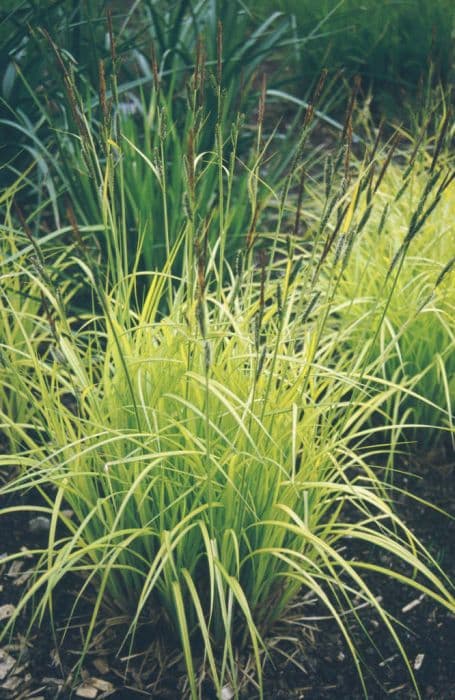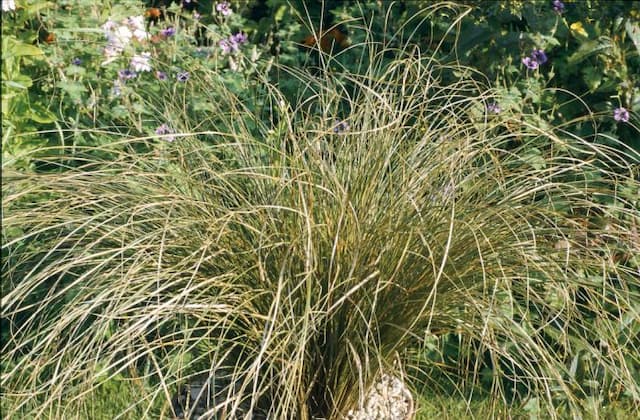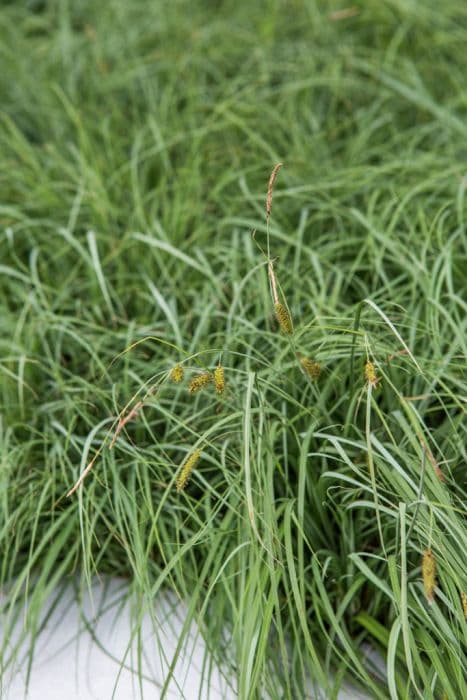Cotton Grass Eriophorum angustifolium

ABOUT
Eriophorum angustifolium, commonly known as common cottongrass or common cottonsedge, is a perennial plant with a distinctive and graceful appearance, characterized by its tufted white cotton-like seed heads. This flowering plant usually displays upright, dark green, grass-like leaves which are narrow and linear. The striking feature of common cottongrass is the fluffy, cottony fibers that surround its small flowers and fruits, giving them a soft, hair-like appearance which is particularly visible during the late spring to summer. These cottony tufts emerge from the top of triangular stems and stand out beautifully against the plant's green foliage and natural habitats. The fibers are commonly used by birds to line their nests. Prior to the development of the cottony heads, the flowers are rather inconspicuous. As the seasons change, the color of the foliage may transition from green to golden brown, adding visual interest to the landscape well into the fall. Despite the lack of details on its dimensions, the presence of common cottongrass is often indicative of wetlands or moist, acidic soil conditions where it thrives and forms extensive colonies.
About this plant
 Names
NamesFamily
Cyperaceae.
Synonyms
Common Cottongrass, Tundra Cotton, Broad-leaved Cotton-grass, Common Cotton-grass, Narrowleaf Cottongrass, Bog Cotton.
Common names
Eriophorum polystachion, Scirpus angustifolius.
 Toxicity
ToxicityTo humans
Eriophorum angustifolium, commonly known as common cottongrass or common cottonsedge, is not widely recognized as a toxic plant to humans. There is no substantial evidence suggesting that Eriophorum angustifolium is poisonous when touched or ingested, nor are there well-documented cases of poisoning. Consequently, there are no specific symptoms associated with the toxicity of this plant, as it is generally considered safe for humans in this respect.
To pets
The common cottongrass, Eriophorum angustifolium, is not generally known to be toxic to pets. There aren't any prominent reports or studies that indicate this plant poses a significant risk if pets consume it. Therefore, there are no specific symptoms of poisoning from common cottongrass documented for pets, and ingestion should not be expected to cause serious harm. However, it is always prudent to monitor pets for any unusual reactions after ingesting any plant material, as individual sensitivities can vary.
 Characteristics
CharacteristicsLife cycle
Perennials
Foliage type
Deciduous
Color of leaves
Green
Flower color
White
Height
1-2 feet (30-60 cm)
Spread
1-2 feet (30-60 cm)
Plant type
Herb
Hardiness zones
3-9
Native area
Circumboreal
Benefits
 General Benefits
General Benefits- Wildlife Habitat: Eriophorum angustifolium, commonly known as cotton grass, provides shelter and breeding grounds for various wildlife species, especially insects and birds.
- Erosion Control: The robust root system of cotton grass helps stabilize soil and control erosion in wetland environments.
- Water Filtration: Cotton grass contributes to the filtration and purification of water by trapping sediments and absorbing nutrients in wetland ecosystems.
- Carbon Sequestration: As a peat-forming plant, cotton grass plays a role in carbon sequestration, capturing and storing atmospheric carbon dioxide.
- Landscaping: Cotton grass is used in garden ponds and wetland landscaping for its aesthetic appeal, especially when its white tufts resemble tufts of cotton.
- Indicator Species: Being sensitive to changes in its environment, cotton grass serves as an indicator species for monitoring the health of wetland habitats.
- Biodiversity Support: By forming a part of the wetland ecology, cotton grass supports biodiversity and forms symbiotic relationships with other plant and microbial life.
 Medical Properties
Medical PropertiesThis plant is not used for medical purposes.
 Air-purifying Qualities
Air-purifying QualitiesThis plant is not specifically known for air purifying qualities.
 Other Uses
Other Uses- Cotton-Grass is used in the production of handcrafted paper due to its long cellulose fibers, which can be processed to create a distinctive texture.
- Its fluffy seed heads can be incorporated into floral arrangements or crafts, providing a natural and unique aesthetic.
- Indigenous populations have traditionally used the plant's stems for weaving into mats and other items, employing its strength and flexibility.
- The plant can be utilized as a natural dye, where different parts produce varying shades, contributing to sustainable textile coloring practices.
- Fiber obtained from Cotton-Grass has been used for stuffing pillows and bedding, serving as an eco-friendly alternative to synthetic materials.
- Its seed fibers have been used as wicks in traditional oil lamps, due to their ability to draw up liquids via capillary action.
- Artisans have used the fibrous material in the creation of eco-conscious textiles, emphasizing the plant’s role in sustainable fashion.
- In landscaping and garden design, Cotton-Grass can be planted to create visually striking accents in bog gardens or around water features.
- Conservationists utilize Cotton-Grass to stabilize soils and prevent erosion in wetland restoration projects.
- The seeds of Cotton-Grass, being lightweight and abundant, have been tested as natural insulation materials for environmentally friendly building practices.
Interesting Facts
 Feng Shui
Feng ShuiThe Cotton Grass is not used in Feng Shui practice.
 Zodiac Sign Compitability
Zodiac Sign CompitabilityThe Cotton Grass is not used in astrology practice.
 Plant Symbolism
Plant Symbolism- Resilience - Eriophorum angustifolium, commonly known as Cotton Grass, often thrives in challenging environments such as wetlands and bogs, symbolizing the ability to endure and adapt.
- Purity - The white tufts of cotton-like fibers can represent purity and innocence, much like cotton itself historically symbolizes.
- Simplicity - Cotton Grass has a straightforward and unpretentious appearance, representing the value of simplicity in life.
- Transition - Found in places that transition between aquatic and terrestrial ecosystems, Cotton Grass may symbolize change and the passage between states or phases.
 Water
WaterCotton-grass prefers consistently moist soil, so it should be kept damp but not saturated. Watering should be thorough, ensuring that the soil is evenly moist to a depth of several inches. In dry conditions, watering may be necessary every few days, aiming for about 1-2 gallons per week depending on the climate and soil drainage. In wetter climates or during periods of rainfall, reduce watering accordingly to prevent waterlogging, which can cause root rot in this species.
 Light
LightCotton-grass thrives in full to partial sunlight, with at least 6 hours of direct sun exposure being optimal. It is perfectly suited for an open spot where it will receive plenty of light throughout the day. Avoid deeply shaded areas as a lack of sufficient sunlight can hinder its growth and the development of its characteristic fluffy seed heads.
 Temperature
TemperatureCotton-grass is cold-hardy and can tolerate a wide range of temperatures, flourishing in areas with temperatures that fluctuate between 32°F and 70°F. It can survive freezes and is well-adapted to cold climates, but prolonged exposure to temperatures above 70°F can stress the plant. The ideal growing conditions are cool to moderate temperatures, reflecting its natural bog and wetland habitats.
 Pruning
PruningPruning cotton-grass is generally not necessary as it naturally maintains its growth form. However, if desired for aesthetic reasons or to remove dead foliage, pruning can be done in late autumn or early spring before new growth begins. Cut back the foliage to just above the water line or ground level using clean, sharp shears.
 Cleaning
CleaningAs needed
 Soil
SoilCotton Grass (Eriophorum angustifolium) thrives in a mix of peat and acidic sandy soil with good moisture retention, mimicking its natural boggy habitat. A pH of around 4.5 to 6.5 is ideal for this plant. Ensuring that the soil is consistently wet without being waterlogged will support healthy growth.
 Repotting
RepottingCotton Grass generally does not require frequent repotting and can be left undisturbed for several years as it prefers to grow in stable conditions. If rootbound or showing signs of stress, repotting every 2-3 years in spring may be beneficial.
 Humidity & Misting
Humidity & MistingCotton Grass flourishes in high humidity conditions, closely resembling its natural bog and wetland habitats. Maintaining a high humidity level, often above 75%, is ideal for mimicking the conditions this plant thrives in its native environment.
 Suitable locations
Suitable locationsIndoor
Keep moist and in high humidity.
Outdoor
Plant in wet areas, partial to full sun.
Hardiness zone
3-9 USDA
 Life cycle
Life cycleCommonly known as the common cottongrass or common cottonsedge, Eriophorum angustifolium begins its life cycle when the seeds, typically dispersed by wind, land in suitable wetland habitats. Germination follows, requiring cold stratification and often taking place in spring as temperatures rise. Seedlings establish themselves in the soggy, acidic soil, common to bogs and moors, developing a root system adapted to such conditions. Vegetative growth progresses, with the plant forming tufts of narrow, grass-like leaves. The distinct flowering stage occurs from late spring to summer, marked by white, cotton-like tufts that arise from modest, brownish spikelets, aiding in seed dispersal. After setting seed, Eriophorum angustifolium enters a period of dormancy during the winter months, resuming growth with the return of warmer temperatures.
 Propogation
PropogationPropogation time
Spring-Early Summer
Propogation: Commonly known as Cotton Grass, Eriophorum angustifolium can be propagated most effectively through seed sowing. Timing for propagation by seeds occurs in the fall after the seed has ripened. To propagate Cotton Grass by seeds, distribute them evenly on a well-drained, peat-based seed starting mix, covering them with a thin layer of soil. The seeds have to be kept moist until germination, which generally happens within two to three weeks. Once seedlings have emerged and reached a sufficient size to handle, they can be potted into individual containers and grown on in cooler conditions before planting out.









![Japanese sedge [Everest]](/_next/image?url=https%3A%2F%2Fplants-admin.emdemapps.com%2Fimages%2Fplants%2F%2Fimages%2F604b5b6de0548.png&w=640&q=75)